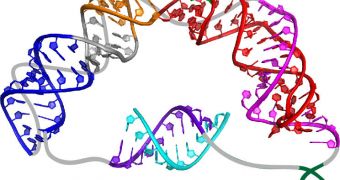A group of scientists announces the creation of the first thee-dimensional model of telomerase, a special enzymes that plays a key role in regulating the life span of cells. The finding could aid the fight against cancer and aging.
The main role that telomerase has is to maintain the quality and quantity of DNA located at the ends of each of out chromosomes. This special type of deoxyribonucleic acid is called a telomere.
Telomeres get shorter each time our cells divide, if telomerase does not act on them. This is a natural occurrence, and is a critical part of the aging process.
Researchers say that there isn't much telomerase activity in the average human cells. As a result, when telomeres get too short following repeated cell divisions, the cell dies.
This is in important mechanism the body uses to prevent harmful mutations, that can occur in cells as they age. But, in some diseases, the mechanism malfunctions, and starts working against humans.
When cells turn cancerous, for example, the telomeres act as protective caps at the ends of chromosomes, and get their DNA content replenished by telomerase. This allows them to endure, and live a life that is much longer than it should be.
Controlling telomerase, an enzyme made out of proteins and ribonucleic acid (RNA), is therefore one of the avenues worth exploring in the fight against cancer and age-induced degradation.
As part of this effort, researchers at the University of California in Los Angeles (UCLA) have produced a detailed 3D model of the RNA “core domain” inside telomerase. Biochemists at the university say that this study could help further other researches considerably.
Understanding the structure of this critical enzyme is therefore very important in this regard.
“We still do not know how the RNA and the proteins cooperate to do this magical thing – extend the ends of our telomeres – but we are now one step closer to understanding that,” explains Juli Feigon.
She holds an appointment as an UCLA professor of chemistry and biochemistry, and is also the senior author of a new research paper detailing the findings.
The work has been published in the November 2 print issue of the esteemed journal Proceedings of the National Academy of Sciences (PNAS).
“Telomerase is the most amazing complex. Some people think if we activate telomerase, we can live forever. However, we don't want our cells to be able to divide indefinitely,” Feigon adds.
“As they get older and older, they accumulate all kinds of DNA damage and defects; that is why we don't want to have a high level of telomerase activity in most of our cells,” she concludes.

 14 DAY TRIAL //
14 DAY TRIAL //